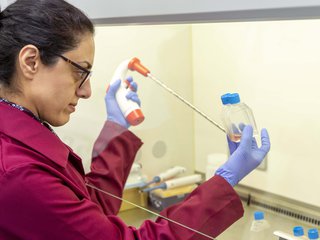Acute myeloid leukaemia (AML) causes
AML happens when something goes wrong in the DNA inside growing blood cells. We don’t know exactly why this happens to some people and not others.
AML risk factors
There are some things that make a person slightly more likely to get AML – these are called risk factors. But most people with these risk factors never develop AML. And other people without any risk factors can still develop AML.
So as we explain some of the risk factors below, it’s important to remember that AML can happen to anyone, and it’s not because of anything you have done.
Age
Like most cancers, AML is more common in older people. This is because the longer we live, the more chance there is for accidental errors to happen in our DNA.
Just over 2,900 people are diagnosed with AML each year in the UK. People of all ages can develop AML, but you’re more likely to get AML over the age of 60. The most common age to develop AML is between 85 and 89 years old. Around a quarter of people who are diagnosed are under 60.
In some very rare cases, children can develop AML. We have separate information about childhood AML.
Sex at birth
People who are born male are slightly more likely to get AML than people born female, but we don’t know why. Around 44% of AML cases in the UK are in females, and 56% are in males.
Family history
In most cases, AML doesn’t run in families. But in some families, there are more cases of AML than we’d expect to occur by chance. If you are worried about leukaemia in your family, talk to your doctor.
Smoking
Long-term exposure to certain chemicals could increase the risk of getting AML. One of these chemicals is called benzene, which is found in cigarette smoke. This could explain why people who smoke have a slightly higher risk of getting AML, although most people who smoke never get AML.
Other conditions
If you have another condition which affects the production of myeloid blood cells, such as myelofibrosis or myelodysplastic syndromes (MDS), you can be at higher risk of getting AML. There are specific treatments for AML that has developed from another blood condition.
Previous cancer treatment
Some people develop AML after having chemotherapy, radiotherapy or other specific drugs in the past for another illness. The AML can develop a number of years later.
This type of AML is called treatment-related or therapy-related AML (tAML). Certain types of treatment are more likely to cause this than others.
Your chance of developing treatment-related AML (tAML) is based on the type of treatment you originally had for the other illness or cancer.
If you have treatment-related AML (tAML), we have more information about how this might impact your prognosis.
Genetic disorders
Children with Down's syndrome are at an increased risk of developing any type of acute leukaemia. We have separate information about childhood leukaemia.
There are also some rare inherited genetic mutations that can make a person more likely to develop AML, such as the genetic mutations RUNX1 and DDX41. These are explained more on our page about prognosis and genetic mutations.
We are continuing to fund research that is looking how and why AML develops, so we can find new ways to treat it.

Because research will beat blood cancer
Over 60 years, we've invested more than £500 million in blood cancer research which has led to a long line of breakthroughs that have improved treatments and saved lives.
